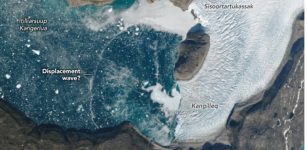Paratethys: The Largest Known Lake On Earth
Eddie Gonzales Jr. – MessageToEagle.com – For the first time ever, research led by one of Utrecht University’s earth scientists – Dr Dan Palcu – has earned a place in the Guinness Book of World Records.
The megalake holds the Guinness World Record for the largest known lake on Earth. It extended over an immense area of 2.8 million square kilometers, eclipsing even the vastness of the modern Mediterranean Sea. Within its confines, it harbored a remarkable reservoir of about 1.77 million cubic kilometers of water, a quantity exceeding the combined volume of all presently existing freshwater and saltwater lakes by more than tenfold. The vastness of the lake could encompass the joined land areas of France, Spain, Sweden, Germany, Finland, Norway, Poland, Italy, United Kingdom, Romania, Greece, Hungary, Portugal, Czechia, and Austria.. Image credit: Utrecht University
His fascinating research shows the immense proportions of the largest lake the Earth has ever seen: the Paratethys. Guinness World Records published a whole page about the ‘Largest lake ever’ on their website, as well as a highlight in the print edition.
Dr Dan Palcu and the Paleomagnetic Laboratory Fort Hoofddijk of the Department of Earth Sciences played an essential role in determining the exact dimensions of Lake Paratethys. Utrecht’s researchers employed a technique called magnetostratigraphy whereby the reversals of the earth’s magnetic field are used to date sediment layers from the distant past in order to determine the size and volume of Paratethys. Their contributions were thereby essential to this fascinating story led by Palcu.
Unique endemic fauna
Around 11 million years ago the European continent looked very different from today. The most impressive feature was probably the Paratethys – a water body stretching all the way from the Alps to Central Asia. This megalake formed through the raising of central Europe’s mountain ranges, thereby separating the ancient Paratethys Sea from the ocean and forming megalake Paratethys, the largest lake ever. Palcu and his colleagues determined the megalake’s proportions in a study published in June 2021. At its peak,
Deinotherium giganteum flourished in the megalake’s surrounding swamps and lowlands. Image credit: Utrecht University
Paratethys stretched over an area of around 2.8 million square kilometers, filled with more than 1.8 million cubic kilometers of brackish water. This is more than ten times the volume of all current salt- and freshwater lakes combined. Paratethys was characterized by a unique endemic fauna, including Cetotherium riabinini – the smallest whale ever found in fossil records.
Tumultuous history
Palcu and his colleagues unraveled the tumultuous history of the Paratethys, marked by multiple hydrological crises and desiccation periods. During the most severe crisis, the megalake lost more than two-thirds of its surface and one third of its volume, with water levels plummeting by as much as 250 meters. This had devastating impacts for the endemic fauna and many species became extinct. At some point, the lake refilled again, connecting it with the Mediterranean Sea and thereby relieving it of its spot of largest lake ever.
Climate fluctuations
Dr Palcu highlights the profound significance of their research: ‘Our exploration of the Paratethys goes beyond mere curiosity. It unveils an ecosystem acutely responsive to climate fluctuations. By exploring the cataclysms that this ancient megalake endured as a result of climate shifts, we gain invaluable insights that can elucidate the path to addressing current and future crises in toxic seas, such as the Black Sea.’
Rocks formed during the megalake crises have become cliffs overlooking the Black Sea, one of the few remains of the ancient megalake. Cape Kaliakra, Bulgaria. Credit: Utrecgt University
He explains that the modern Black Sea mirrors the hazardous conditions of its ancient counterpart, Paratethys. Largely devoid of life-sustaining oxygen, its depths house hydrogen sulfide, a toxic gas harmful to both humans and most animal species. Furthermore, its sediments hold ‘frozen’ methane, an exceptionally potent greenhouse gas that could be released into the atmosphere in response to global warming, thereby triggering environmental catastrophes.
Carbon storage
Dr Palcu, who is currently researching the resilience of these environmentally-fragile regions to climate change and human-induced alterations through a Veni-funded project, emphasizes that understanding the Paratethys is not just a journey into the tragic past but also a beacon of hope for the future: ‘The modern Black Sea has the potential to become one of the Earth’s largest natural carbon storage regions. Its stability is of paramount importance in unlocking its capacity as a frontrunner site for future carbon storage initiatives’.
International collaboration
Earning a place in the Guinness Book of World Records is a huge achievement and will inform many about the fascinating science around this megalake. The study that inspired the Guinness Book of World Records to dedicate an item to the Paratethys was a collaboration between Utrecht University (Netherlands), the University of São Paulo (Brazil), the Russian Academy of Science, the Senckenberg Biodiversity and Climate Research Centre (Germany) and the University of Bucharest (Romania). It was published in 2021 and led by Dr Dan Palcu.
Source – Utrecht University
Written by Eddie Gonzales Jr. – MessageToEagle.com Staff Writer













